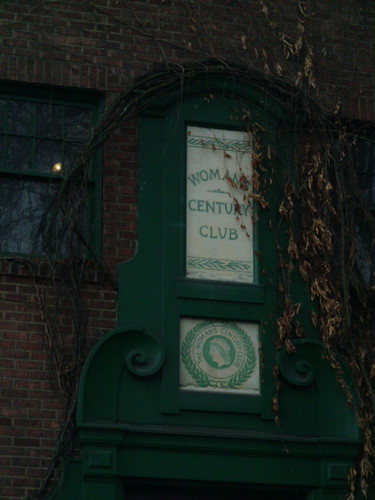
A unique joint meeting of Historic Seattle and the Woman’s Century Club will be held on Friday, April 20, at noon at the Harvard Exit Theatre. Members will speak about the club’s history; rarely seen artifacts from the club’s archives will be on display; and short tours will be given, with special attention to the building’s former role as the clubhouse for the Woman’s Century Club from 1925 to 1968.
The program is free and open to the public. A light lunch will be available.
The Woman’s Century Club was founded in 1891 – 121 years ago – by a small group of trailblazing Seattle women, including a 32-year-old suffragist who would go on to become world-famous – Carrie Chapman Catt. She was a protégé of Susan B. Anthony, and after women got the right to vote in 1920, she went on to found the League of Women Voters.
A history book made by club members in the early 1890s explained why the founders created the club: “The present is indeed ‘Woman’s Century’ and out of the spirit which has made it such, has grown the organization of such helpful associations for women as the Woman’s Century Club of Seattle, Washington. It had its inception in the minds of a half dozen women who felt its need in the sordid atmosphere of a rapidly developing western city … Its purpose is claimed to be for intellectual culture, original research and the solution of the altruistic problems of the day.”
One of the founding members of the club came to Washington in 1866 on the SS Continental – the ship that also carried the second group of Mercer Girls – though Libbie Peebles was emphatic that she and her sister, Anna, had paid full passage on the ship and had come to find work, not husbands. (They eventually found both.)
Another early member of the club was Emily Inez Denny, a painter and a daughter of the pioneering Denny family. Her club activities included delivering a paper, in 1899, on the founding of Seattle and the Indian War of 1856 – the latter an event she experienced as a three-year-old girl, when she was carried to safety in the city’s blockhouse in her mother’s arms.
By the 1920s the club numbered several hundred women, and they undertook the task of constructing a clubhouse, choosing a site at 807 East Roy. The clubhouse opened in October 1925, and the building was formally dedicated in May 1926. The total cost was just under $60,000. For more than 40 years the building hosted the club’s meetings, talks, teas, receptions, theatrical presentations, and other events — even a 1933 reception for Amelia Earhart, having sponsored her trip to Seattle. And in 1926, the club women helped elect Bertha Landes, a former club president, as the first, and still only, woman mayor of Seattle.
Less is known about the club’s history from the 1940s on, as research on this period has just begun. The club was quite active in the 1940s and 1950s, even maintaining a lively daughters’ auxiliary called the Juniors, but in the ’60s it may have become overwhelmed by the financial challenges of maintaining the building.
In 1968 the club members sold the clubhouse, and it eventually reopened as the Harvard Exit movie theater. A clause in the contract of sale, however, requires maintenance of the parlor as a meeting place for the club. All of the furnishings and artwork in the parlor, and the Steinway piano, remain the property of the club, and members still meet in the parlor, on the third Friday of the month, to this day.
Today the club is a small but growing group of women of diverse ages and professions, and it welcomes new members. This year it has presented monthly luncheons and speakers on women’s history, the arts, and community service. For information on future events or on joining the club, visit the club’s Facebook page or its website, womanscenturyclub.org.


